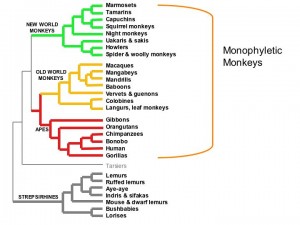Think of a monkey.
What do you see?
I bet that most people picture a chimpanzee, most likely a juvenile chimpanzee, like Curious George (who in the books is always called a monkey). Even though adult chimpanzees look rather like small gorillas – they walk on all fours, they are nearly as big as people, and they are tremendously strong – most people seem to think of chimps as “cute little monkeys.” The monkeys in a Barrel of Monkeys are chimps. Do a Google Images search for “monkey” and you will get some pictures of proper monkeys, but you will also get lots of chimps.
Anyone who knows something about primates, though, knows that chimpanzees are not monkeys. They are apes. And what are apes? They are a group of primates from the Old World (Africa and Eurasia) that don’t have tails. There used to be many more species of them, millions of years ago, but now we just have twenty-odd species, most of which are different kinds of gibbons, plus siamangs, orangutans, gorillas, chimpanzees, bonobos, and humans.
For many years, people used the word “ape” to mean the group of Old World primates that didn’t have tails, but that weren’t humans: that is, all of the apes except us.

More recently, biologists have argued that when we classify living things, we should use only monophyletic groups: groups in which all members are descendents of a common ancestor. Since humans evolved from apes, then, strictly speaking, we are apes.
So what about monkeys? If the term “monkey” does not include the apes, then it is no longer a monophyletic group. A good monophyletic group should include all of the descendents of a common ancestor. In the jargon of taxonomy, Old World monkeys and apes are classified together as Catarrhines (“downward noses”), while monkeys from the New World (North and South America) are classified as Platyrhines (“flat noses”). These are good monophyletic groups. But nobody uses jargon like this in ordinary language. If we translate these terms into ordinary language, we get Old World monkeys (which, to be monophyletic, must include the apes) and New World monkeys. So apes are all monkeys. Which makes you and me monkeys. And any man whose siblings have reproduced is a monkey’s uncle.
So I suggest that we rehabilitate the word “monkey” as a perfectly good word to use in describing chimpanzees and all the other apes, including us. Apes are just one particular branch of the monkey family tree.
When I discussed this in class this spring, one of my students complained that officially classifying apes as monkeys would rob him of the pleasure of correcting strangers at the zoo when they go around calling gorillas and orangutans “monkeys.” To me, though, this seems like a happy case in which ordinary language fits perfectly well with good biology.
This doesn’t always have to be the case. I expect it will take people a while longer to get used to the idea that birds are dinosaurs, and that, monophyletically speaking, we are all fish.
